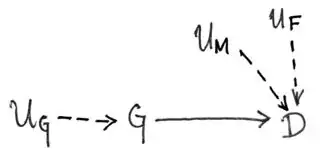Consider the following data generating process:
- A person with gender male or female is selected from a population with probability $\alpha$ of selecting female.
- The person is offered a drug to treat an illness.
- If the person is male, he decides to take the drug with probability $\beta$. If the person is female, she decides to take the drug with probability $\gamma$.
Below I specify what I believe is a faithful probabilistic causal model (PCM) for this process, I'd like to know if there is a simpler one. In particular:
Is there a PCM that faithfully represents the data generating process above but with fewer exogenous variables?
I don't think there is, but for some reason, I feel like the model below is needlessly complex.
Let $U_G$, $U_M$, and $U_F$ be random variables with values in $\{0,1\}$ such that
\begin{align} U_G \sim \mathrm{Bernoulli}(\alpha), \qquad U_M \sim \mathrm{Bernoulli}(\beta), \qquad U_F \sim \mathrm{Bernoulli}(\gamma). \end{align}
Let functions $f_G$ and $f_D$ be defined as follows:
\begin{align} f_G(u_G) = u_G, \qquad f_D(g, u_F, u_M) = gu_F + (1-g)u_M, \end{align}
and define the random variables $G$ and $D$ as
\begin{align} G = f_G(U_G), \qquad D = f_D(G, U_F, U_M). \end{align}
Finally let $U = \{U_G, U_M, U_F\}$, $V = \{G, D\}$, $F = \{f_G, f_D\}$, and $P$ be the probability distribution over $U$ specified above via independent Bernoulli distributions, then $(U, V, F, P)$ is a PCM, and I believe it faithfully represents the process describes above.
The corresponding causal graph is:
The idea here is that the exogenous variable $U_G$ captures the randomness inherent in selecting gender $G$ as either male or female with value $G = 1$ corresponding to female and value $G = 0$ corresponding to male. The exogenous variables $U_F$ and $U_M$ capture the gender-dependent randomness in whether a person will or will not take the drug with $D = 1$ corresponding to taking the drug and $D = 0$ corresponding to not taking the drug. The function $f_D$ is constructed to ensure that if the person selected turns out to be female, the probability of taking the drug follows the distribution of $U_M$ while if the person selected turns out to be make, the probability of taking the drug follows the distribution of $U_F$.
